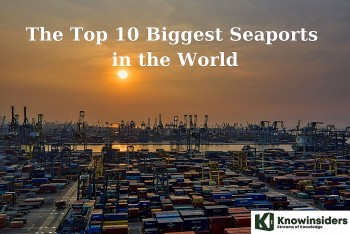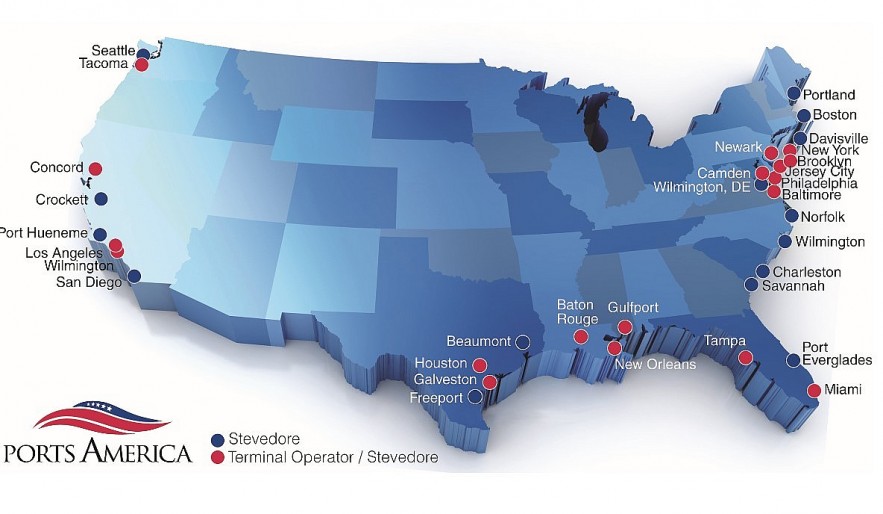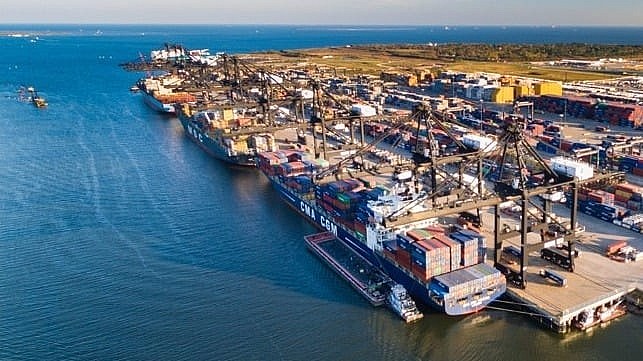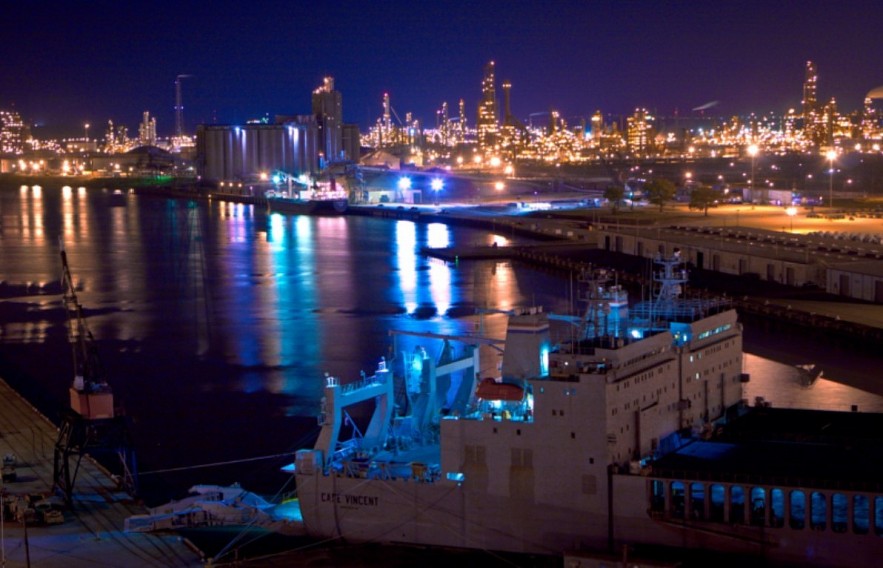Top 10 Largest and Busiest SeaPort in the U.S 2023/2024
 10 Busiest Airports in the United States Today 10 Busiest Airports in the United States Today |
 Top 10 Biggest Seaports in the World Based on Cargo Volume 2023/2024 Top 10 Biggest Seaports in the World Based on Cargo Volume 2023/2024 |
 |
| Top Largest SeaPort In The US |
One of the earliest forms of transportation and shipping, sea freight has become an integral part of the world's supply chain. International ports play a crucial role in linking economies as the volume of trade and import-export activities rises around the world.
Knowing a little bit about the facilities that will handle your ocean freight is always a good idea, and not just because of the significant economic contribution they make to the United States. The United States has seen a dramatic increase in the number of ports along its coastline, streamlining the process of importing and exporting goods of all kinds.
Freight and container leasing costs will be higher if you send your packages through the United States' busiest ports. This is because high-demand areas tend to have higher leasing costs.
| Around 90% of global trade is conducted on ships. Ships have been the most efficient way to transport heavy cargo across the world for countless years. Thousands of containers can be transported through different ports in the United States thanks to large ships. |
1. Los Angeles
The Port of Los Angeles, also referred to as America's Port, is the biggest port in North America. It manages 20% of all incoming cargo for the United States and is spread out over 7500 acres. In comparison to the 9.2 million TEU in 2020, its container volume increased by 16.30% to 10.7 million TEU in 2021.
One of the busiest ports in the world, Los Angeles serves as the main port for the area. It manages a significant amount of trade between the US and Asia.
There are numerous terminals in the Los Angeles port used for various types of cargo. Additionally, it is the location of numerous warehouses and storage facilities. Ships arriving and departing, as well as the loading and unloading of containers, keep the port busy all the time.
529,000 people are employed by the Port of Los Angeles in five counties, and 1.6 million people worldwide. 20% of all cargo entering the United States enters through ports.
Total size: 7500 acres
Cargo terminals: 25
Vessels handled: 1867
Annual cargo tonnage: 222 million metric revenue tons
Annual cargo value: $294 billion
Leading trading partners: China and Hong Kong, Japan, South Korea
Direct and indirect employment: 1.6 million all over the US
Locode: US LAX
Website: https://www.portoflosangeles.org/
2. Long Beach
American container port Long Beach Port, also referred to as the Long Beach Harbor Department, is located close to the Port of Los Angeles. The port in Long Beach, California, with its 3,200 acres (13 km2) of land and 25 miles (40 km) of coastline acts as a significant entry point for US-Asian trade.
Long Beach Harbor is situated 40 kilometers south of downtown Los Angeles and 3 kilometers southwest of the Long Beach city center. The port employs more than 316,000 people in Southern California and generates about $100 billion in trade each year. In 2022, the Port of Long Beach handled 9,133,657 TEUs, but its volume has since decreased by 2.7%.
The Port of Long Beach, which is the second-largest port, is located less than 30 kilometers from the Los Angeles Port. It was established in 1911 and is currently one of the main trade routes connecting Asia and North America.
Through initiatives like the Green Port Policy, the Long Beach Port was one of the first to adopt environmentally friendly policies to lessen its impact on the environment.
Total size: 3200 acres
Cargo berths: 80
Annual cargo tonnage: 78.2 million metric revenue tons
Annual container value: $180 billion
Direct and indirect employment: 370,000
Known for: Environment-friendly policies, including, the implementation of the Clean Air Action Plan
Locode: USLGB
Website: http://www.polb.com/
3. New York and New Jersey
The main port on the US east coast is the Port of New Jersey and New York. The port surpassed the Port of Los Angeles to take the title of busiest port in the US at the end of 2022. Since 2021, the amount of cargo entering the Port of New York and New Jersey has increased by 5.7%.
With 72 percent of all first port of calls going to the New York and New Jersey Port, it is the largest port on the East Coast. It consists of the Port Authority Marine Terminal, the Brooklyn Port Authority Maritime Facility, and the Newark Bay Extension, three main facilities that together handle over 7.4 million containers annually. The port, which includes waterways in the New York-New Jersey Estuary, has two foreign trade zones.
According to the port's administration, the extra cargo was handled without any delays, and the port is not looking to give up on any incoming business.
Container volume: 7.4 million TEUs
Total containers: 4.2 million
Annual cargo tonnage: 74 million metric revenue tons
Annual container value: $205 billion
Leading trading partners: China, India, Germany
Locode: PANYNJ
Website: https://www.panynj.gov/port/en/index.html
4. Georgia Ports (Savannah and Brunswick)
When all four Georgia ports are taken into account, Savannah and Brunswick come in at number four on our list of the biggest ports in North America. They provide a range of shipping services and facilities, such as cruise ship terminals, breakbulk terminals, and container terminals.
The Port of Savannah is home to the largest single-terminal container facility in the nation, whereas more than a dozen automakers use Brunswick as their primary import hub. The Georgia Ports Authority oversees both ports.
In Savannah, Georgia, there is a significant US port called the Port of Savannah. It was the fourth busiest port in the country as of 2021. From both sides of the Savannah River and the Atlantic Ocean, there is a 29 km sailing distance. The Georgia Port Authority's (GPA) Port of Savannah competes primarily with the Ports of Charleston, located northeast of Charleston, South Carolina, and Jacksonville, Florida, located south of Jacksonville.
The Port of Brunswick in Brunswick, Georgia, is another Atlantic port run by GPA. Fort Bainbridge and Port Columbus are two of the inland ports that are connected to the Gulf of Mexico, and Cordillera, Georgia's Port Columbus has a railroad connection to Savannah Harbor.
When combined, Savannah and Brunswick, two of Georgia's four ports, come in at number four on our list of the biggest ports in North America. The Port of Savannah is home to the largest single-terminal container facility in the nation, whereas more than a dozen automakers use Brunswick as an import hub for their vehicles.
Container volume: 4.35 million TEU in Savannah alone
Deepwater terminals: Garden City terminal (1200 acres), Ocean terminal (200 acres)
Primary goods: Automobiles, heavy machinery, agricultural products
Locode: USSAV & USSSI
Website: https://gaports.com/facilities/port-of-savannah/
5. Seattle-Tacoma
One of the busiest ports in the country is the Port of Seattle-Tacoma. It is situated on Puget Sound in Washington state. The port is a major entry point for trade with Asia and handles a lot of container traffic.
An independent seaport called the Port of Tacoma is situated in Tacoma, Washington. On November 5, 1918, Pierce County residents voted to establish the port. In 1921, the Edmore was the first ship to make a port call. In order to create the Northwest Seaport Alliance, the port's marine cargo operations—which are among the biggest in the country—merged with those of the Port of Seattle.
The two ports in Washington were combined in 2014 to form the Port of Seattle-Tacoma. It rose to the third-largest cargo handling company in America in 2015. The port, which contributes significantly to the local economy, generated $9.7 billion in revenue in 2017. The port invested $500 million in Terminal 5 modernization in 2019.
Container volume: 3.7 million TEUs
Total containers: 4.2 million
Primary exports: Oilseeds and grains, machinery, computers
Direct and indirect employment: 151,400
Website: https://www.portseattle.org/, https://www.portoftacoma.com/
6. The Port of Houston
 |
| Port of Houston Busiest US Port |
The Port of Houston is the busiest in America when it comes to foreign waterborne tonnage. There are more than 200 public and private terminals in the 50-mile-long port. The Houston Port, the largest port on the Gulf Coast, transports 52% of the region's project cargo. The NeoPanamax expansion is one of its current areas of emphasis.
Nearly 200 private businesses call the port, a significant hub for maritime trade, their home. Each year, it transports more than 200 million tons of cargo and generates more than $179 billion in economic activity. More than 1.2 million jobs in Houston are supported by the port, which is also a significant employer.
The Port of Houston is a partnership between the Port Authority, which manages important terminals along the Houston Shipping Canal, and more than 150 private businesses situated along Buffalo and Galveston Bay.
Vessel calls: 8200
Barges: 215,000
Annual cargo tonnage: 247 million metric revenue tons
Annual cargo volume: 1.6 million TEUs
Leading products: Petroleum and petroleum products
Economic impact on the state: $339 billion
Direct and indirect employment: 3.2 million
Location: Houston (Texas, USA)
Locode: USHOU
Website: http://www.portofhouston.com/
7. Oakland
Here, the first container ship terminals were constructed. It was the primary port on the Pacific Coast. The Port of Oakland is rated as one of the top three gateways on the West Coast, despite the fact that it frequently gets overlooked in favor of its bigger brothers. The Port of Oakland includes nearly 2,000 acres of waterfront property and is situated on San Francisco Bay in Oakland, California.
Ninety-nine percent of all containerized goods that travel through Northern California are handled by the port. It serves as a significant entry point for trade with Asia and handles more than two million containers annually.
Vessel arrivals: 1775
Annual container volume: 2.5 million TEUs
Leading trading partner: Asia
Locode: USOAK
Website: http://www.portofoakland.com/
8. South Carolina (Georgetown and Charleston)
The South Carolina ports are comprised of the ports in Georgetown and Charleston. Given that the port directly or indirectly supports 10% of all jobs in South Carolina and pays wages that are 32% above the state average, it is clear how significant the port is to the state's economy.
With an annual capacity of over two million TEUs (twenty-foot equivalent units), the port places a strong emphasis on containers. The port serves as a major hub for the import and export of automobiles as well as bulk goods like coal and forest products.
Annual cargo volume: 1.29 million TEUs
Foreign ports served: 100
Economic impact: $63.4 billion
Direct and indirect employment: 187,200
Locode: USGGE, USCHS
Website: https://scspa.com/locations/port-of-georgetown/ , http://scspa.com/
9. Virginia
With millions of tons of cargo handled each year, the Port of Virginia is one of the busiest and most significant seaports on the East Coast. The port is situated in Virginia's Hampton Roads area, where the James River and Chesapeake Bay meet.
One of the busiest ports on the East Coast, the Port of Virginia, has been expanding at a 2.6% yearly rate for the past five years. It can only get busier at the port as multinational corporations like Amazon and Navien establish operations there.
The principal terminals in this area are Norfolk, Portsmouth, Newport, Virginia International, and Virginia Inland. The Savannah and Virginia ports' Georgia-Virginia agreement has been approved by regulators, and the port is anticipated to gain significantly from the combined economies of scale.
Major terminals: 5
Container volume: 3.7 million TEUs
Direct and indirect employment: 397,000
Economic impact on the state: $92 billion
Locode: USEUV
Website: https://www.portofvirginia.com/
10. The Port of Beaumont
 |
| The Port of Beaumont |
Deep-water port Beaumont Port is situated in Beaumont, Texas, close to the Nechez River estuary. According to the 2018 US Port Authority Rating by the American Association of Ports Authorities and ranked by the American Association of World Ports Authorities, it is the fourth busiest port in the United States.
In terms of tonnage, Beaumont Port is ranked 47th in the world. 2013 Port Rankings Report. The world's busiest naval port is also where US military surplus is recycled. The port houses the 842nd Convoy's headquarters, which specializes in port logistics and is part of the US Army.
Location: Beaumont, Texas
TEUs: updating
Manager & Operator: Port of Beaumont Navigation
Locode: USBPT
Website: http://www.portofbeaumont.com/
Port of MiamiThe Port of Miami, which made it to our top ten list, handled 1,114,900 TEUs in 2021. Did you know that it is the only seaport in the southeast that can accommodate Neo-Panamax ships? This is due to the fact that it has the deepest shipping channel among all seaports in the southeast. Grapefruit, citrus fruit juices, poultry, dairy products, bitters, brandy, and cognac are among the exports from this country. Fruits, vegetables, frozen fish, shrimp, prawns, wine, and vodka are examples of imports. |
FAQs
What’s the busiest port in the US?
The busiest port in the US is now the Port of New Jersey and New York. At the end of 2022, the port surpassed the Port of Los Angeles to become the busiest port in the US.
What are the 5 largest ports in the US?
The five largest ports in the US are, The port of Los Angeles, The port of Long Beach, the Port of New Jersey and New York, the Port of Savannah, and the Port of Norfolk.
What is the second largest port in the US?
The second largest port in the US is the Port of Long Beach.
Conclusion
That's quite a long list of America's busiest seaports. Now you should have a basic knowledge of the reasons why these ports are always crowded.
One example is how the United States' power and wealth affect international trade. This is why the ports in this region play such a crucial role as global economic trade hubs. There are many active ports because of the high volume of goods moving in and out of the country via imports and exports. In fact, the United States is also making a name for itself in the container manufacturing sector.
The busy ports also benefit from a historical explanation. The United States makes excellent use of its waterways. Many construction projects were once carried out along their rivers. So, they built harbors on the water's edge and a number of river ports and jetties. That resulted in a greater total of available ports.
The United States' ports have become some of the busiest in the world due to rising imports and exports and increased participation in global trade.
 Top 15 Largest Hotels in the World By Number Of Rooms Top 15 Largest Hotels in the World By Number Of Rooms A good hotel makes your vacation great. Let check out the top 15 biggest hotels in the world below! |
 Top 10 Largest Cereal Brands in The United States Today Top 10 Largest Cereal Brands in The United States Today With delicious taste, easy to eat, and high quality and nutritional value, cereals are increasingly popular in people's lives. Here are the top 10 popular ... |
 How Many Islands Are There in the US: 20 Largest, The Best and Full List How Many Islands Are There in the US: 20 Largest, The Best and Full List How many islands does the United States of America have? There are 18,617 islands that the US claims as its own. What are the best ... |
 Top 20 Largest Global Tech Companies 2023 by Brand Value Top 20 Largest Global Tech Companies 2023 by Brand Value Today, technology companies have emerged as a key driver of economic growth, consumer preferences, and financial markets. |























